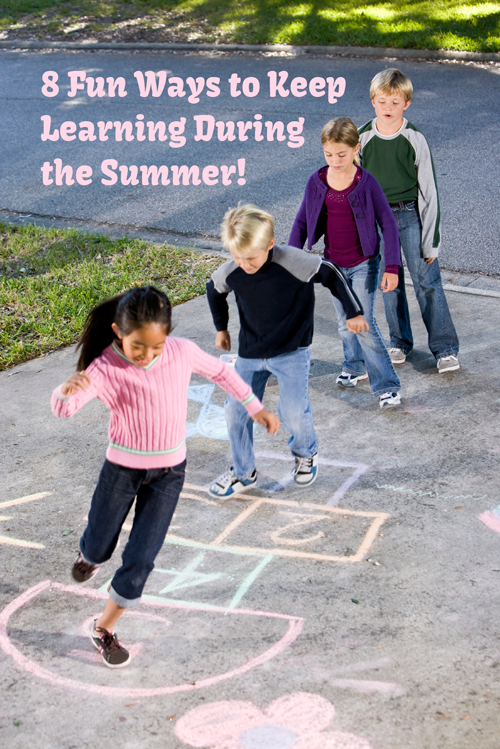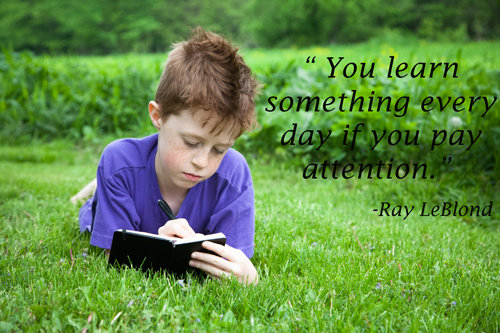With the summer months upon us we have entered the “summer slide” where students began to forget what they’ve worked so hard to learn the past nine months. That old saying “use it or lose it” can be really true. Those times tables are not like riding a bike; if you don’t keep up with them, you will forget. However, continuing to learn over the summer doesn’t have to be a drag!
Check out these 7 fun ways to keep learning during the summer:
1. Learning About Something You Love
Summer is the time to really take advantage of the freedom you have when it comes to learning. You are not restricted the same way you are during the school year. If you have a child that is reluctant about school, show them how fun learning can be. Let your child choose a topic that they are interested in; maybe they are obsessed with all things related to the ocean or model airplanes. If they are interested in a topic and know that they have the freedom to spend the time learning about it, they will be much more open to the idea of learning over the summer. You can find books at the library or search the Internet for articles. Even Youtube could hold some educational treasures on the topic.
2.Vocabulary Challenge Jar
Learning new words is something we should never stop doing. It is something relevant to all ages. From kindergartners learning new exciting words to high school students preparing for the SATs, there is value in learning new words for everyone. So why not make a game out of it? Get your whole family involved. Grab a jar and fill it with slips of paper that include different vocabulary words. They don’t all have to be new words. Try using some words that your child would know but maybe doesn’t use very often. Each day draw a word from the jar. The challenge is to see who in your family can use the word the most often in context throughout the day. Keep a tally somewhere. Maybe the winner gets a prize or gets to draw the word the next day. As a parent, you can also make it a goal to use previous days’ words to see if your child recognizes them.
Here are some links to great vocabulary lists:
- Kindergarten – 8th grade - https://www.flocabulary.com/wordlists/
- High School - http://www.majortests.com/word-lists/
3. BINGO!
Try turning goals into a game. Create a BINGO board where each square represents a goal for you child. The great thing about this is that you can really tailor it to your children’s age and needs. If you want to encourage your child to read more over the summer, try creating goals for them in each square. You can make the goals specific to different kinds of books, such as “Read a fiction book”, “Read something with a female protagonist”, and “Read something from the point of view of an animal”. You can also make the goals specific to location or time, such as “Read for at least 30 minutes in one sitting”, “Read under a tree”, and “Read upside down”. Then once your child completes 5 in a row (BINGO!), have some sort of prize or treat for them.
Bingo doesn’t just have to be reading specific. You can create similar goals for any kind of learning or behavior you want to reinforce this summer!
4. Sidewalk Chalk
Use sidewalk chalk to create some fun, interactive educational games by drawing a hopscotch court on the sidewalk or on the trampoline. Here are a few ideas of activities you can do:

- Write down the letters of the alphabet and have your child jump to them to spell words. You could even have them only jump to letters that will create a word.
- Write down words in the squares and have your children toss a beanbag on one and then give a word that rhymes with the word it landed on.
- Write down verbs and, using beanbags, have different rounds where your children have to give a sentence using the different forms of the verb (past, present and future).
- You can do similar things with numbers as well. Instead of words or letters, make a number line. This can be good for upper elementary students as they begin to learn about the integers. You can walk (or jump) out addition and subtraction problems.
5. Learning Something New Everyday Journal

Challenge your families to keep a journal this summer.
But instead of filling it with, “Dear Diary” entries, make it a goal to learn something new every day. Then write it down in your journal. If your child is artistic, encourage them to decorate and illustrate each page. You can use color and add stickers or magazine clippings. Then at the end of each day (or week), you can sit down with the family and have everyone share what they’ve learned. This would also be a great way to do a family Bible study or book club.
6. Water Balloons
Fill up some water balloons and grab some sharpies. Write math problems on the balloons and then write possible answers on the targets. Your child would need to say the problem out loud, solve it, and then do his or her best to throw the balloon at the target with the correct answer. To make it a little more complicated and to practice those pesky order of operations, you could have a part of an expression on a balloon and throw the balloon at the target with the rest of the expression.
7. Story Stones
Get practice writing this summer by making and using story stones. Collect some rocks and paint images on them. Make sure to get some nouns as well as actions. For example, you can paint some trees, a river, a sword, a prince or princess, and a dog. Then paint running, swimming, laughing, and cooking. Once the stones have had time to dry have your child pick up a few. You can place them in a bag or just have them close their eyes. Then they have to create and write a story that uses all the images on the stones that they chose.
I hope these ideas will spark some fun learning for your family this summer!

